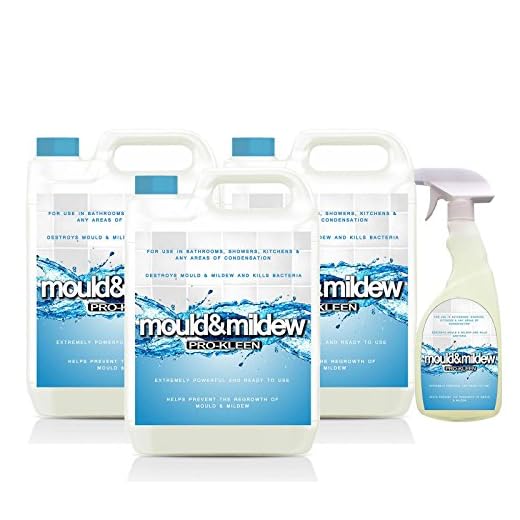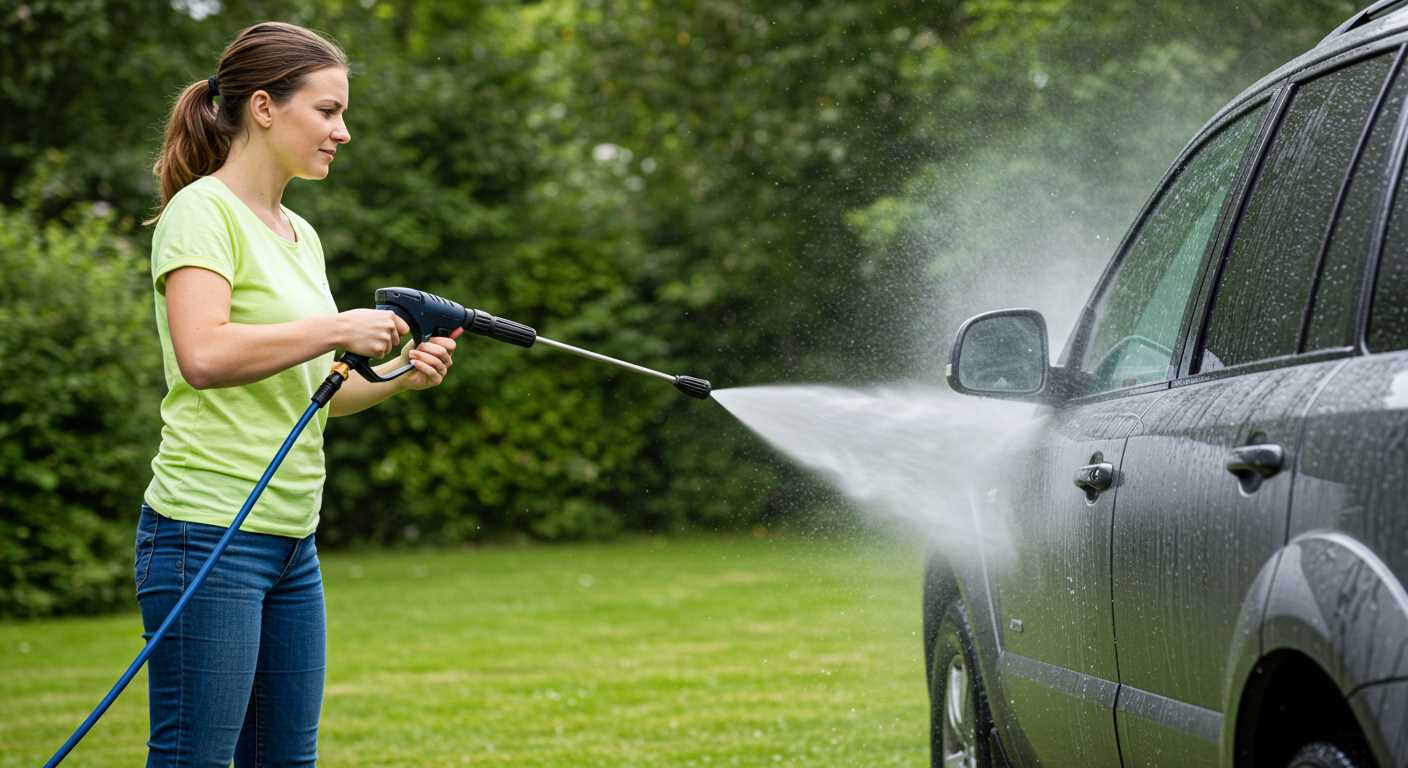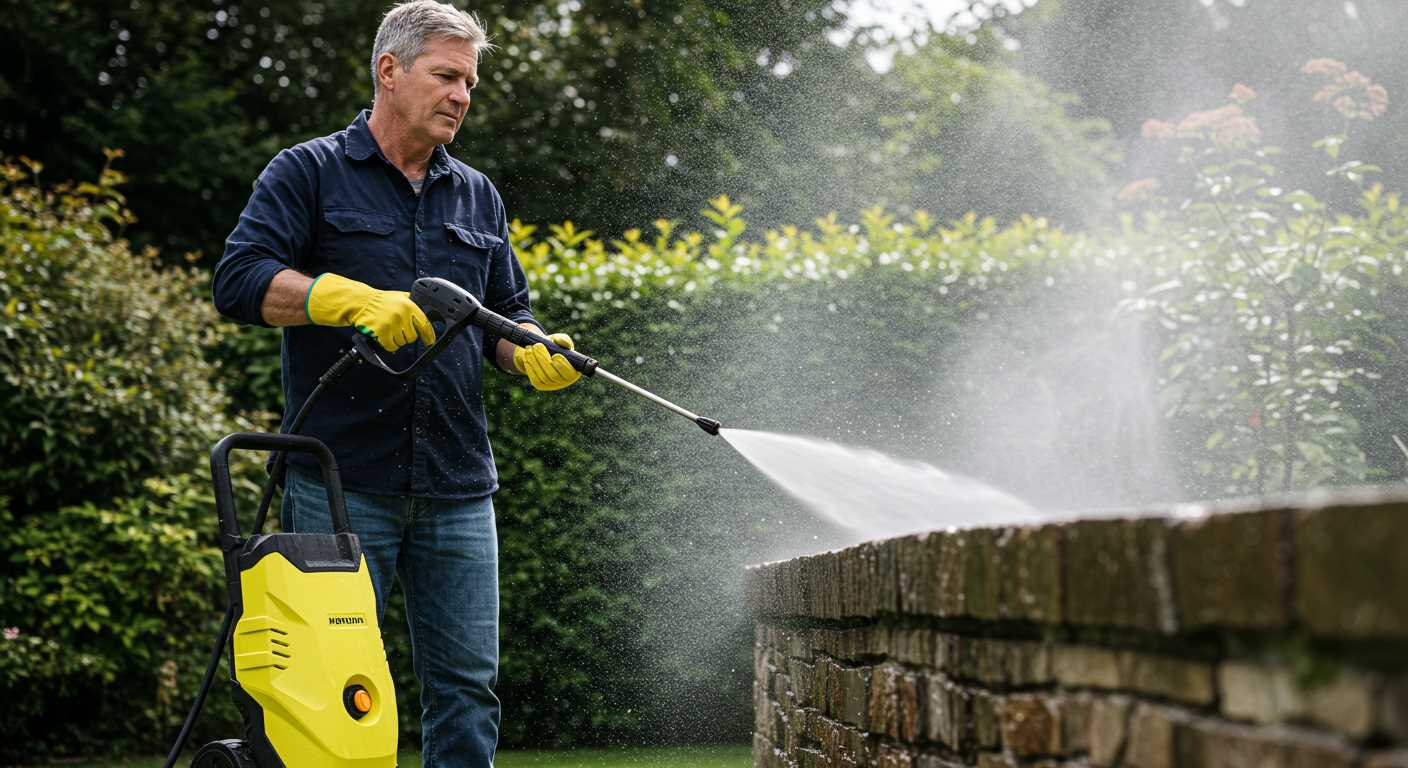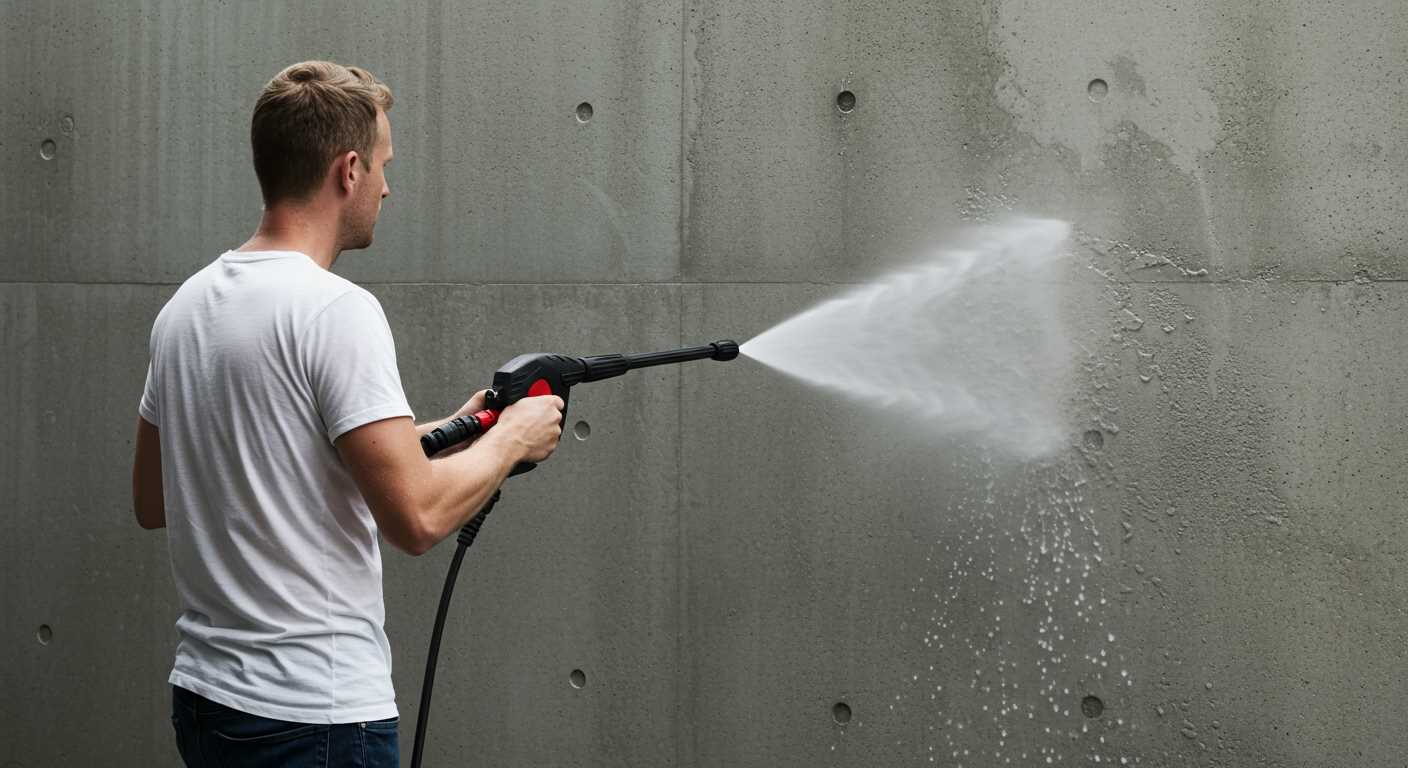



Start by selecting the appropriate nozzle for the task at hand. A wide-spray tip is ideal for delicate surfaces, while a narrower jet can tackle tougher grime on concrete or brick. Adjusting the nozzle not only optimises the process but also prevents damage to your exteriors.
Next, ensure you apply a suitable detergent if the grime is particularly stubborn. Pre-soaking the areas will lift dirt and mildew, making your work significantly easier. Most high-pressure units are compatible with detergents designed specifically for use with them, enhancing the cleaning process without causing harm.
Before you begin, make sure to clear the area of any obstacles. This allows for unobstructed access and minimizes the risk of damaging plants or other fixtures. Working methodically in sections will help you maintain focus and ensure no spots are overlooked. Keeping the nozzle at a consistent distance–typically around 30 cm–helps achieve even results and prevents etching into surfaces.
Lastly, be cautious around windows and delicate materials. High-pressure streams can easily crack glass or strip paint. A gentle touch and strategic angling will keep surfaces intact while still allowing for a thorough cleanse. Following these practical steps can rejuvenate the exterior of your property with minimal effort.
Effective Techniques for Exterior Surfaces Using a High-Pressure Cleaner
Begin by selecting the appropriate nozzle; a 25-degree tip is ideal for most surfaces. Adjusting the spray width allows for a targeted approach, preventing unintended damage.
Preparation Steps

- Remove furniture and decorations to have an unobstructed area.
- Ensure nearby windows and doors are closed to prevent water ingress.
- Cover any plants or delicate items that may be affected by the high spray.
- Inspect surfaces for cracks or loose materials to avoid further issues.
Cleaning Techniques
- Begin at the highest point, usually the eaves or roof, working downward to avoid re-soiling areas already cleaned.
- Maintain a distance of about 2 feet from the surface while spraying, gradually moving closer if necessary.
- Utilise a sweeping motion, overlapping each pass slightly for uniform results.
- For tougher stains, apply a suitable detergent before washing, allowing it to sit for a few minutes.
- Rinse with clean water, ensuring all detergent residues are eliminated.
Experience plays a significant role. Each session offers insights into what techniques work best for specific materials and conditions. Regular maintenance will prolong the cleanliness of these areas, making future tasks easier and less demanding. Adjust your approach based on surface type–wood, brick, or stone each has unique requirements for optimal results.
Choosing the Right Cleaning Equipment for Your Needs

Consider your specific tasks before deciding on a suitable model. For regular maintenance, a unit with moderate pressure (around 1500-2000 PSI) is often sufficient. If tackling stubborn stains like oil or grime, opt for a machine with higher PSI, generally around 3000. This power level is ideal for tough surfaces.
Types of Models
There are generally two main types to consider: electric and gas-powered units. Electric models are quieter and easier to operate, making them perfect for small to medium jobs. Conversely, gas-powered options provide more power and mobility, suited for extensive tasks. Think about the size of your area to determine what fits best.
Key Features to Evaluate

When assessing options, focus on the following features:
| Feature | Benefits |
|---|---|
| Adjustable Nozzles | Allows versatility for different surfaces. |
| Detergent Tanks | Enables effective cleaning for various materials. |
| Portability | Look for lightweight designs with wheels for easy transport. |
| Power Rating | Affects cleaning efficiency; higher ratings suit demanding tasks. |
In conclusion, clarity on your requirements will assist in making an informed decision. Pay attention to both the intended use and the specifications of each model to maximise your cleaning potential.
Preparing Your Outdoor Area Before Cleaning
Clear the space of furniture, pet items, and plants to prevent damage. Move patio furniture, decorative pieces, and any obstacles that may obstruct the cleaning process.
Cover delicate plants with tarps or cloths for protection against splashes. Ensure the ground is dry to avoid slips and falls while operating machinery.
Check for any loose elements like shutters or siding; secure or remove them beforehand. Inspect areas for grime buildup so you can focus on spots needing extra attention.
Consider using a solution for tough stains. Apply it to surfaces before starting the machine, allowing it time to work in. Set up a drainage plan; if possible, direct water flow away from structures to prevent pooling.
Ensure all electrical connections in your working area are safe and functional. Use extension cords designed for outdoor use to avoid hazards while powering equipment.
Selecting the Appropriate Cleaning Solutions
Opt for specialised formulations tailored for various surfaces to enhance effectiveness. For instance, a degreaser works wonders on garage floors, while a mildewcide is ideal for wooden decks. It’s critical to read the labels for compatibility with equipment and surfaces.
Types of Solutions
- Detergents: Use for stubborn grime; biodegradable options are environmentally friendly.
- Acids: Safe for concrete and brick but test a small area first to avoid damage.
- Sodium hypochlorite: Effective against mould and mildew but must be rinsed thoroughly post-application.
- Soap-based cleaners: Gentle yet effective for painted surfaces; ensure they’re rinseable and non-abrasive.
Mixing Solutions

Follow manufacturer instructions precisely when diluting. A typical ratio is 1:10 for most concentrates, but always verify to prevent equipment damage. Never mix different products unless specified, as reactions can produce harmful fumes.
Testing a solution on a concealed section before full application helps assess its impact on the surface. This precaution can save time and prevent costly repairs.
For environmental considerations, choose eco-friendly alternatives where available. This not only protects the surroundings but also minimises potential harm to plants and pets.
Techniques for Cleaning Different Surfaces
For wooden decks, use a wide-angle nozzle to avoid damaging the surface texture. Keep the spray at a 45-degree angle and maintain a distance of about 12 inches to prevent splintering.
When tackling driveways, I recommend employing a rotary nozzle. This attachment increases surface area coverage and enhances effectiveness against embedded dirt and oil stains. Move at a consistent pace for even results.
Brick and masonry respond best to a narrow nozzle, coupled with a cleaning solution specifically designed for these materials. Apply the detergent, let it sit for 10 minutes, then rinse thoroughly to reveal the surface’s original colour.
For roofs, a lower pressure setting is crucial to prevent tiles from dislodging. Use a fan spray pattern, and work from the top down to allow debris to wash away without collecting on lower sections.
Siding materials, like vinyl or stucco, benefit from a two-step approach: first, spray with a soap attachment to loosen grime, then follow up with a standard nozzle for rinsing, ensuring you don’t create streaks.
For vehicles, a gentle spray setting is critical. Maintain at least two feet distance, and utilize specialised vehicle-cleaning detergents to avoid damaging the paintwork.
Outdoor furniture can be tackled with a medium-pressure setting. Start from the top of each piece and work downwards, ensuring that no residue is left in crevices and joints.
For patios and pathways, utilise a surface cleaner attachment. This tool allows for consistent cleaning across large areas, ensuring no streaks or missed spots.
Always adjust your technique based on the specific material and the type of grime you’re encountering. It’s essential to test on a small, inconspicuous area first to avoid any potential damage.
Safety Measures to Consider When Using a Pressure Washer
Always wear eye protection to shield your vision from debris and spray back. A full-face shield offers enhanced safety when working with strong jets.
Dress appropriately by opting for long sleeves, sturdy shoes, and gloves. Waterproof boots are preferable to prevent slips on wet surfaces.
Before operating the machine, inspect the power supply to ensure no frayed wires exist, minimising electrocution risks. Ensure your workspace is free of unnecessary obstacles that may cause trips or falls.
Keep bystanders, especially pets and children, at a safe distance. Establish a designated area where others should stay clear while you work.
Utilise a nozzle suited for the task; incorrect tips can lead to damage or injury. Maintain a firm grip on the lance to control powerful jets effectively.
Never aim the stream at yourself or anyone else, regardless of the distance. It can penetrate skin and cause severe injuries.
Be mindful of your surroundings. Avoid working near power lines, fragile structures, or environments where chemicals might be present, as pressure washing can create hazards.
Store and handle cleaning solutions with care, as some may be harmful or irritative. Refer to product labels for usage instructions and safety precautions.
Lastly, ensure the equipment is correctly set up before starting. Familiarise myself with the manufacturer’s guidelines, including pressure settings and operates safely to enhance overall experience.
Maintaining Your Pressure Washer After Use
After finishing your cleaning task, immediately disconnect the water supply and turn off the motor. Release any remaining pressure in the system by pulling the trigger on the spray gun. This prevents any potential damage to the unit and ensures safety.
Cleaning the Components
Remove any detergent or cleaning solutions used during operation. Rinse the detergent tank thoroughly and run clean water through the system for a couple of minutes. This helps prevent clogs and residue buildup. Inspect the nozzle for any blockages and clean it using a small wire, if necessary, to maintain optimal performance.
Storage Practices
.jpg)
Store the device in a dry, protected area to avoid moisture-related issues. If the unit has a removable electric cord, gently coil it without kinks and store it separately. Check the hose for any signs of wear or leaks, rolling it up loosely to prevent twists or damage. Periodically inspect seals and fittings, replacing any worn parts to prolong its lifespan.
FAQ:
What preparations should I make before using a pressure washer on the exterior of my house?
Before using a pressure washer, it’s important to prepare the area adequately. Start by clearing the vicinity of any furniture, plants, or decorations that could get damaged or obstruct your cleaning path. Check the condition of your pressure washer to ensure it’s working correctly; inspect hoses and connections for leaks. It’s also advisable to wear suitable protective gear, such as goggles and gloves, to shield yourself from debris and chemicals. If you’re using any detergents, read their instructions carefully and ensure they are appropriate for your pressure washer model.
What surfaces can I effectively clean with a pressure washer?
A pressure washer can clean a variety of surfaces outside your house. It is ideal for patios, driveways, sidewalks, and decks, removing dirt, grime, and stains with ease. You can also use it on siding to clean away mildew and weather stains, although it’s wise to adjust the pressure to prevent damage to softer materials like wood or vinyl. Additionally, you can use a pressure washer on outdoor furniture and garden tools, making it versatile for maintaining the cleanliness of your exterior space.
Are there any safety precautions I should take while using a pressure washer?
Absolutely, safety precautions are necessary when operating a pressure washer. Always keep a safe distance from the surface you are cleaning to prevent injury from the high-pressure water. Make sure to aim the nozzle away from people, pets, and electrical outlets. It’s also wise to avoid using a pressure washer on ladders or steep surfaces where you might lose your balance. Lastly, ensure that any chemicals you are using are safe, and follow manufacturer guidelines to prevent harmful reactions.










